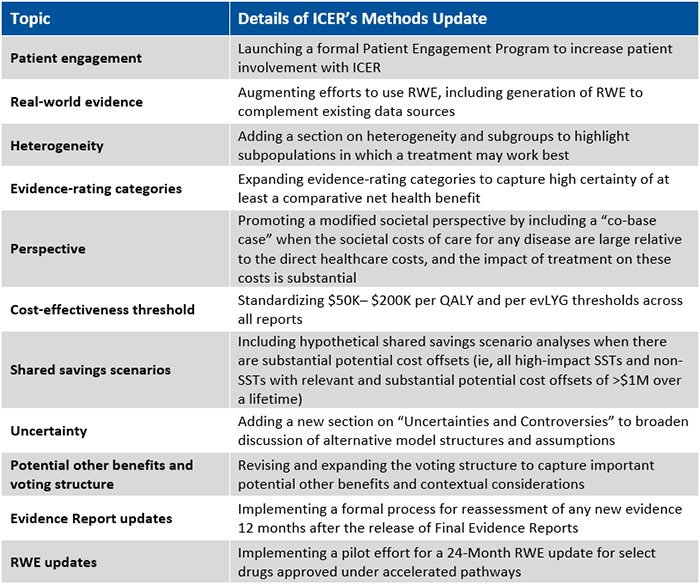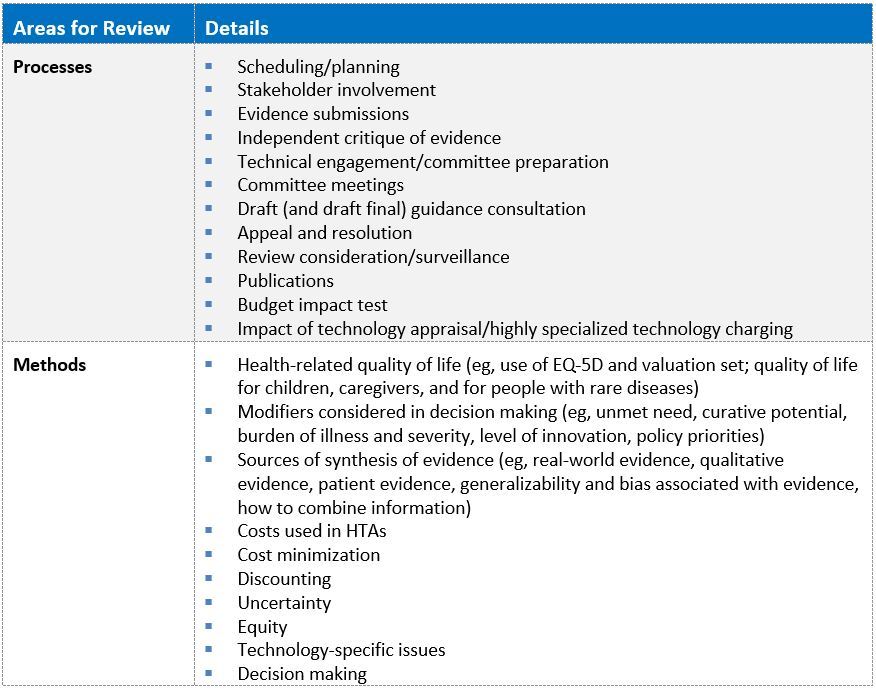A Tale of 2 Frameworks: Impact of ICER and NICE Updates on Future HTAs and Market Access
By Xcenda
HTA QUARTERLY | SPRING 2020
A Tale of 2 Frameworks: Impact of ICER and NICE Updates on Future HTAs and Market Access
The National Institute for Health and Care Excellence (NICE) and the Institute for Clinical and Economic Review (ICER) are recognized health technology assessment (HTA) bodies that independently conduct economic evaluations of healthcare interventions by comparing clinical efficacy and safety, estimating incremental cost-effectiveness of one or more interventions relative to a common comparator, and providing determinations regarding the value of a treatment in terms of the cost per quality-adjusted life-year (QALY) gained.
NICE, established in 1999 with the aim to “create consistent guidelines and end rationing of treatment by postcode across the UK,” is one of the most recognized and notable HTA bodies. Today, NICE strives to provide high-quality, high-value care to citizens of the United Kingdom (UK) by issuing national guidance and advice on improving health and social care. A positive appraisal by NICE is a requirement for funding of treatments by the National Health Service (NHS) England, and all treatments recommended by NICE’s technology appraisals must legally be funded and resourced by the NHS.
In comparison, there is no formal government HTA body or process established in the United States (US) due to the decentralized healthcare system. Rather, over the past 5 to 10 years, independent organizations have emerged to assess the value of new interventions through their internally established value assessment frameworks (VAFs). Arguably the most influential of these organizations is ICER. Founded in 2006 and modeled after NICE, ICER has unofficially emerged as the “USA’s independent watchdog on drug pricing.” ICER aims to objectively evaluate the clinical and economic value of prescription drugs, medical tests, and other healthcare innovations through its VAF methodology. ICER analyzes the clinical data and publicly convenes key stakeholders—including patients, physicians, life science companies, private insurers, and the government—to translate this evidence into recommendations that are made publicly available, with no formal role in policy decision making.
Methodologies utilized by NICE and ICER need to be regularly updated to stay relevant in the ever-changing healthcare landscape. NICE is in the process of reviewing and updating its current methodology, while ICER recently published its updated methodology for 2020–2023 in January 2020 (Figure 1). What implications will these updates have on manufacturers looking to commercialize health technologies in these markets over the next several years, and what is the impact on evidence generation requirements? This article examines and compares the current and forthcoming method updates to help shed light on these questions.
Figure 1. Timeline for 2020 Update to ICER’s VAF and NICE’s Methods Review
ICER
ICER has historically updated its VAF methodology every 2 years and has encouraged input from stakeholders, including patients, providers, payers, and manufacturers, during the update process. ICER’s 2020 VAF update was a nearly a year-long effort that included several opportunities for stakeholders to provide comments to ICER regarding all aspects of its evaluation process, spanning any topic from ICER’s mission and rationale to technical details about ICER’s VAF methodology. ICER also specifically encouraged patient stakeholder input on 3 key areas:
- Understanding the diversity of patient experience and of what matters most to patients
- Incorporating patient-generated evidence
- Integrating dimensions of value not captured by QALYs
ICER released a draft proposed set of changes to its 2020 VAF update in late summer 2019 that were based on ICER’s experience evaluating products, conversations with international HTA agencies, and input received from stakeholders across the US health system. ICER also held a public webinar for patient organizations and the general public to review ICER’s mission and the rationale behind the proposed framework updates, as well as how the open input period feedback was integrated into the proposed changes. The proposed changes were subject to another public comment period before ICER released its Final 2020–2023 Value Assessment Framework in January 2020. Key updates to ICER’s VAF methodology are listed in Table 1.
In parallel with efforts to update its 2020 VAF methodology, ICER was working on its “Valuing a Cure” initiative, which adapted the methods of its 2017–2019 VAF in order to be applicable in the assessment of potential curative treatments and other treatments qualifying as “single or short-term transformative therapies” (SSTs). As these SSTs often come with notably high price tags and efficacy benefits and safety benefits that can’t be fully quantified at time of approval, traditional cost-effectiveness analytical methods are not always appropriate for providing accurate benchmarks of their value. ICER encouraged public input from stakeholders for its Valuing a Cure initiative as well, which included feedback received during a live meeting with guest panelists from NICE, the Canadian Agency for Drugs and Technologies in Health (CADTH), and US stakeholders (ie, payers, patients, manufacturers, health economists). The final white paper outlining ICER’s approach for evaluating SSTs was published in November 2019.
Table 1. Key Updates Included in ICER’s 2020–2023 VAF

Key: evLYG – equal value of life-years gained; ICER – Institute for Clinical and Economic Review; RWE – real-world evidence; QALY – quality-adjusted life-year; SST – single or short-term transformative therapy; VAF – value assessment framework.
NICE
In spring 2019, NICE announced plans to undergo a review of its current processes and methods. NICE last conducted its processes review in 2018 and its last methods review in 2013. NICE’s update is part of a regular methodology review process that allows NICE to stay up to date with evaluating innovative medical developments such as personalized medicines, digital health tools, and cell and gene therapies. In November 2019, NICE held a webinar to share how and why health technology evaluation is changing and what it means for stakeholders. NICE is expecting to implement changes to their methods in 2021.
Many stakeholders are involved in NICE’s review process, including representatives from NICE, NHS England, manufacturers, patients, and stakeholders from academia. A steering group, manual working group, process working group, methods working group, stakeholder insight group, and patient involvement working group will all collaborate to execute the review process. The working groups will commission the development of topics, use their expertise to make operational decisions about the review, make recommendations to the steering group regarding methods, and oversee the delivery of the work that is instructed by the steering group. The patient working group is intended to include feedback from patient organizations, encourage discussion of patient involvement in other HTA processes, and identify factors of value that are important to patients. NICE’s new methodology will apply to technology appraisals, highly specialized technologies, medical technologies, and diagnostics assessment programs.
A broad set of topics will be considered in NICE’s review of its HTA processes and methods (Table 2). Reviews of both processes and methods will be conducted in parallel, with the ultimate goal of providing 1 document that includes both processes and methods that is easy to navigate, rather than following the precedent of publishing a separate guiding document for the processes review and methods review individually.
Table 2. Key Areas Included in NICE’s Review Process

Summary
Both ICER and NICE strive to best determine the value of a treatment to inform coverage decisions. As ICER is growing in prominence, there has been increased collaboration with established HTA bodies, such as NICE, through global stakeholder participation in ICER webinars and the development of other ICER initiatives. As we examine the methodological updates for both organizations, clear trends that demonstrate similarities in the process and topics for updates are emerging.
Increasing levels of patient engagement is a prominent area of focus for both ICER and NICE as they revisit their methodologies. Both HTA bodies are encouraging greater patient involvement and are seeking to increase patient engagement throughout their respective assessment processes.
- ICER has outlined steps for outreach to patient groups in advance of an evaluation to prepare patient organizations for participation in ICER evaluations. To gain insight on elements of value that matter to patients, ICER will also engage with patients and patient organizations throughout the evaluation at various points: to understand the disease burden; to ensure that patient input is captured in ICER’s economic models; to identify gaps in key outcomes measures; and to identify, use, and generate RWE. Additionally, after each review, ICER will invite participating patient groups to debrief and will offer to co-author a letter to the FDA and other stakeholders with key policy recommendations.
- NICE currently invites patients to participate in webinars and public meetings and welcomes patient input and feedback as part of their review process. NICE stated that going forward in its updated methodology, it plans on differentiating the impact of patient stakeholder feedback—compared to the impact of other stakeholders and clinical evidence—through patient engagement surveys and correspondences with patients and patient organizations that participate in a NICE review process.
Additional areas that ICER and NICE are focusing on during their respective updates include:
- Uncertainty: ICER plans to include a new section in its 2020 VAF that is dedicated to discussing uncertainties in model structure and model assumptions that are suggested by manufacturers or other stakeholders for all evaluations. In its methods review, NICE has stated that it plans on evaluating various modifiers that are considered in decision making, which can differ based on the type of treatment being reviewed and how the modifiers influence NICE’s assessment of products (eg, high unmet need, curative potential, burden of illness and severity, level of innovation, policy priorities).
- How to best evaluate high-cost, high-value therapies (eg, curative therapies): ICER’s recently published Valuing a Cure white paper outlines details for evaluating SSTs. NICE has not yet specifically outlined if there will be an update for differentiated methodology to evaluate curative treatments (eg, SSTs) or rare diseases.
- Inclusion of other elements of value in cost-effectiveness assessments: ICER’s 2020 VAF has increased the number of categories included in its Potential Other Benefits and Considerations in order to include elements of value, which may not be captured by clinical trials, RWE, or economic modeling for panel deliberation and voting. NICE’s methods update will include a review of how health-related quality of life is currently captured in assessments (eg, use of EQ-5D to inform the QALY) and if there are alternative methods to better capture quality of life for all patients, including children, caregivers, and those with rare diseases.
Regular updates to processes and methodologies are essential for HTA bodies to keep up with the changing landscape and the emergence of new, innovative treatments. It’s encouraging to see both ICER and NICE evolving to address recent advances in healthcare and to see similarities in their areas of focus. In these updates, both organizations are acknowledging that capturing the value of high-cost treatments requires more than just looking at QALYs and incremental cost-effectiveness ratios. Both organizations are uniquely demonstrating purposeful efforts to account for additional dimensions of value, though the biggest challenge lies ahead in turning ideas into action, with additional dimensions of value being quantitatively influential in the ultimate assessment.
The article should be referenced as follows:
Kanaskar A, Tan R, Watts-James J. A tale of 2 frameworks: impact of ICER and NICE updates on future HTAs and market access. HTA Quarterly. Spring 2020. https://www.xcenda.com/insights/htaq-spring-2020-2-frameworks-icer-nice-hta-market-access
Sources:
- ICER. 2020 value assessment framework. https://icer-review.org/topic/2020-value-assessment-framework/. Accessed February 3, 2020.
- ICER. 2020 value assessment framework: final framework. January 30, 2020. https://icer-review.org/material/2020-value-assessment-framework-final-framework/. Accessed February 3, 2020.
- ICER. About. https://icer-review.org/about/. Accessed February 14, 2020.
- ICER. Guide to understanding health technology assessment (HTA). August 2018. http://icer-review.org/wp-content/uploads/2018/08/ICER-Guide-to-Understanding-Health-Technology-Assessment-6.19.18.pdf. Accessed February 14, 2020.
- ICER. Valuing a Cure. November 2019. https://icer-review.org/material/valuing-a-cure-final-white-paper-and-methods-adaptations/. Accessed December 16, 2019.
- NICE Decision Support Unit. NICE methods guide update. 2013. http://nicedsu.org.uk/methods-development/nice-methods-guide-updates/. Accessed February 10, 2020.
- NICE. Changes we’re making to health technology evaluation. https://www.nice.org.uk/about/what-we-do/our-programmes/nice-guidance/nice-technology-appraisal-guidance/changes-to-health-technology-evaluation. Accessed February 5, 2020.
- NICE. Guide to the processes of technology appraisal. April 2018. https://www.nice.org.uk/Media/Default/About/what-we-do/NICE-guidance/NICE-technology-appraisals/technology-appraisal-processes-guide-apr-2018.pdf. Accessed February 10, 2020.



